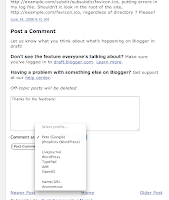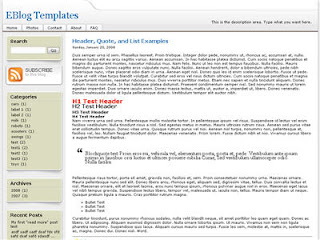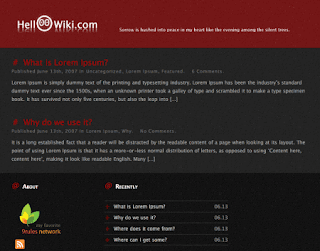The Associated Press is reporting that they have come to has an "accord" with Rogers Cadenhead, the owner of the Drudge Retort : “Both parties consider the matter closed.”
The AP seems to be committed to clarify how much text
it thinks bloggers and social news sites can reprint from its articles without violating copyrights. The AP is insisting that
bloggers cannot quote the headline of an A.P. story or its first paragraph. While the law is not settled,
many lawyers suggest that such short excerpts are permitted under the “fair use” exception to the copyright laws.In response to questions about the use of Associated Press content on the Drudge Retort web site, the AP was able to provide additional information to the operator of the site, Rogers Cadenhead, on Thursday. That information was aimed at enabling Mr. Cadenhead to bring the contributed content on his site into conformance with the policy he earlier set for his contributors. Both parties consider the matter closed.
In addition, the AP has had a constructive exchange of views this week with a number of interested parties in the blogging community about the relationship between news providers and bloggers and that dialogue will continue. The resolution of this matter illustrates that the interests of bloggers can be served while still respecting the intellectual property rights of news providers.
In a statement Friday, Rogers Cadenhead said he is "glad" the dispute over his site, the Drudge Retort , has ended. He said a larger conflict remains between AP's view of acceptable use of its content and the practices of many bloggers. Cadenhead declined to comment further, referring all questions to his attorney. Earlier this month the AP sent a legal notice ordering Cadenhead to take down seven entries on the Drudge Retort, his takeoff on the Drudge Report . The news agency said the postings were violating the AP's copyright.
Cadenhead highlighted the disagreement in his personal blog, http://www.Cadenhead.org , and prominent bloggers rallied behind him, saying the posts in question were protected under the "fair use" provision of copyright law . That allows quotation of copyright material for commentary and certain other purposes without asking permission.
In response, the AP said it was working to develop guidelines for what it considered permissible use of its content by bloggers. The AP's plan for such guidelines was met with new criticism from some bloggers, who said it was an attempt by the AP to create its own legal definition of what constitutes "fair use" of copyright material.
Cadenhead's post on AP dispute on his personal blog:
http://www.cadenhead.org/workbench/news/3372
Written by
Rogers CadenheadAP Settles Dispute with Drudge Retort
Late Thursday night, AP issued the following statement after a day-long discussion of the DMCA takedowns issued to the Drudge Retort that reached all the way up to the company's top management:
In response to questions about the use of Associated Press content on the Drudge Retort web site, the AP was able to provide additional information to the operator of the site, Rogers Cadenhead, on Thursday. That information was aimed at enabling Mr. Cadenhead to bring the contributed content on his site into conformance with the policy he earlier set for his contributors. Both parties consider the matter closed.
In addition, the AP has had a constructive exchange of views this week with a number of interested parties in the blogging community about the relationship between news providers and bloggers and that dialogue will continue. The resolution of this matter illustrates that the interests of bloggers can be served while still respecting the intellectual property rights of news providers.
I'm glad that my personal legal dispute with the AP is resolved, thanks to the help of the Media Bloggers Association, but it does nothing to resolve the larger conflict between how AP interprets fair use and how thousands of people are sharing news on the web. You could probably guess that by the lack of detail in AP's statement.
I spent around two hours yesterday talking to AP attorneys about their specific objections to the user blog entries in dispute, going line by line through the text to pinpoint exactly where they have intellectual property concerns in the short excerpts that were posted. I won't reveal the details of this discussion until AP releases the guidelines for bloggers that it promised on Monday.
On a social news site that's still manageable in size, like the 8,500-member Drudge Retort, it's possible to steer bloggers away from potential conflicts with media organizations by working directly with users. But 25 million people visited a social news site last month, and thousands of people are sharing news links in a way that's in direct conflict with AP's interpretation of fair use regarding the headlines and leads of its articles.
If AP's guidelines end up like the ones they shared with me, we're headed for a Napster-style battle on the issue of fair use.
When it appeared that I might end up in court on this issue, I got offers of help from the Electronic Frontier Foundation, Public Citizen and the Stanford Fair Use Project. My attorney Wade Duchene and I were already working up the victory speech to deliver on the steps of the Supreme Court in the landmark First Amendment decision AP v. Me (Justices Stevens, Ginsburg, Breyer, Souter, Kennedy, Lessig, Tribe and Clinton concurring).
I think AP and other media organizations should focus on how to encourage bloggers to link their stories in the manner they like, rather than hoping their lawyers can rebottle the genie of social news. Given the publicity of this dispute, the first blogger sued for excerpting a news story will have the best pro bono legal representation that massive press attention can buy.
Although AP will be releasing guidelines, I don't think the news service will be able to concede any ground to the blogosphere. AP sells headline and lead-only services to customers. Asking the company to concede there's a way people can share this information for free is like asking the RIAA to pick its favorite file-sharing client.
If an expansive view of fair use is to remain in place, it's incumbent upon bloggers and our $500-an-hour friends in the legal community to define our own guidelines and fight for them. If we don't, big media companies will eventually define them for us, just as they've gotten the Digital Millenium Copyright Act and Copyright Term Extension Act passed in Congress.
I have learned that the Drudge Retort popped up on AP's radar through its use of Attributor technology to find potential cases of copyright infringement, as K.C. Jones reported in InformationWeek:
Attributor launched last year, with company representatives saying they would identify and "fingerprint" chunks of content from more than 10 billion pages on the Internet. The company provides a service to media outlets and other content creators to track how their content is reused online and whether the user has authorization to reproduce the material.
"Our agreement with Attributor will enable AP to safeguard its investment in creating and distributing news reports, while assuring licensees that unauthorized use will not diminish the value of their licenses," AP general counsel Srinandan Kasi explained in the announcement. "These services are part of the next-generation licensing and enforcement services we plan to provide to our global network of members and subscribers."
Earlier this year, Attributor told its customers that when a case might be fair use, it's better to ask for credit than to file a DMCA takedown:
No one wins when a DMCA notice is sent. First, unless you have an open and shut case, a DMCA notice can be a PR risk for the DMCA sender. Next, the site hosting the content has to deliver the bad news to its user putting them in an unfavorable spot. Finally, consumers lose overall because the result of content removal is one less place to find quality content. ...
You can't send a DMCA notice if it's Fair Use -- and Fair Use is usually not a black and white situation. The fairness of asking for a link is indisputable.
As a newspaper reader since age 8 and the spouse of an investigative reporter, I want the media to keep making enough money to afford the expensive and essential practice of journalism. I sure as hell don't want to do all that reporting myself.
If AP's core business is to report the news, blogs and social news sites send millions of people to its articles every day. Retort users have posted 41,000 links to news stories in the last four years, each link sending from 1,000 to 5,000 readers directly to a media site to read the article.
If its core business is to repackage the news, they're in as much trouble as every other middleman on the web.
Cadenhead's Drudge Retort Web site: http://www.drudge.com/
Unfortunately, for the AP, you cannot own the news. You can own your words but, anyone can be privy to the news. You can own the photos but, in a nation that promotes the freedom of speech you cannot own the news itself.
AP cannot win over the millions of bloggers. AP should try to find a compromise that will benefit their reputation and the blogging communitiy which, in the end will only make the AP look better and bring them more business. The blogging community is only getting bigger and in reality the AP needs bloggers to survive.






























